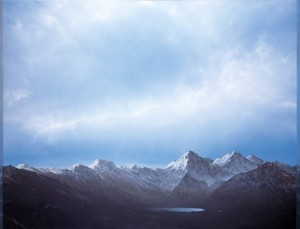Telfair’s “Imaginary Landscapes” Debuts in New York Gallery

Professor of Art Tula Telfair’s latest exhibition, Out of Sight: Imaginary Landscapes, opened at the Forum Gallery in New York, N.Y. on Jan. 5 to a packed crowd. The 15 large panoptic paintings shown in the exhibition, which ran through Feb. 11, depict majestic mountainous landscapes dominated by dramatic skies that reflect a broad range of locations and weather patterns.
As with Telfair’s past work, her landscapes are derived from memory and imagination. Telfair, director of Wesleyan’s Arts Studio Program, finds it fascinating when people tell her they can identify a particular location, since none actually exist.
“Since I have no idea when I begin what the final image will be, it feels like I’m exploring new territory when I start a painting, and that’s very exciting. Because I can easily copy images, I tended to lose interest in the process when I worked from observation,” she explains. But by painting from her imagination and memory, she is challenged intellectually, technically and emotionally. “Successfully painting an image that was not observed, but that viewers are convinced exists, is gratifying.”
Telfair works on many canvases simultaneously. She begins by mixing colors for the skies and starts painting each one intuitively.
“They’re typically active, changing and full of clouds. Each painting will present a unique weather system, and hopefully exhibit a distinctive mood. They may be foggy, stormy, colorful, cloudless or hazy,” she says.

Next, Telfair paints the earth. “In my earlier work, the landscape was gentle and rolling and offered tranquility in the face of active skies,” Telfair says.
In her recent paintings, she found herself focusing on mountains that included rolling green hills, soaring gray peaks and snowy bowls.
“I paint spontaneously, so each landscape completely changes several times before I settle on what the final image will be. I was excited to face the challenge of creating quiet images where the land forms would be as structurally dynamic as the dramatic atmosphere above.”
To access the actual views represented in these pictures would require strenuous physical effort. Telfair feels mountains can be, “mysterious because they are simultaneously beautiful and daunting. They aren’t an easy landscape to paint or to occupy. The complex nature of what they represent is different from the bucolic pastoral images that I painted for my last exhibition. One of my greatest pleasures is creating different types of landscapes from show to show. The next group of paintings I make will portray vast epic spaces and varied landscapes from around the globe.”
Telfair says her work is fundamentally about natural beauty, weather, flux and memory. She recalls, as a young child, traveling to different countries multiple times a month because her father was a geological mining engineer, and being struck by the sharp differences in climate. Walking across the tarmac to the airplane in her home country of Gabon, the air would be oppressively hot and humid; hours later she would exit the plane in Switzerland and be hit in the face with dry frigid air. “I guess the extreme differences in climate and environment made a enormous impact,” she reflects, though she had no idea at the time that those early experiences would inform her work.

Today, Telfair does a different kind of travel: the long drive between her home in New York City and Wesleyan’s Middletown campus. “I get to see a lot of landscape zipping by,” she says.
Telfair feels that most city dwellers pay little attention to the natural environment around them. They notice temperature and precipitation, but not the sky. “They don’t look up much,” she says. Yet, she notes that most people relate directly to landscape paintings.
“I’m interested in triggering a connection for viewers with the places I depict; bringing them face to face with a poetic and awesome wilderness, or a familiar welcoming romantic landscape. I hope my paintings have the capacity to evoke memories and inspire awe. I paint landscapes because they have the power to make people aware that they are alive.”

